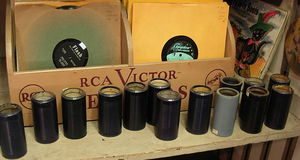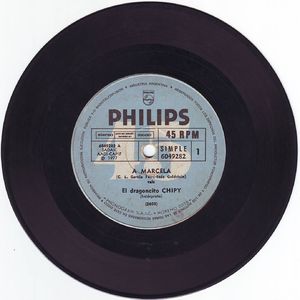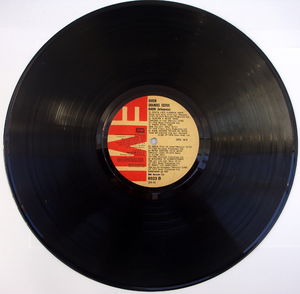Mass Producing Records
When Thomas Edison invented the phonograph he imagined many uses for a recording and playback machine. However, within a few years of the phonograph’s introduction, market forces had narrowed down those options to just one: playing music. The popularity of playing music on the phonograph created a demand for mass production of records. Making copies of records in very large quantities was the key to making the modern record industry.
The original Edison phonograph recorded on a sheet of tinfoil that could be stored, folded, or even mailed. Edison believed tinfoil records could be duplicated in mass quantities. However, when Chichester Bell and Charles S. Tainter improved Edison’s basic machine in the 1880s, they switched from tinfoil to wax cylinders. Recordings on wax sounded better and Edison made the switch too.
The Edison wax cylinder phonograph of the 1890s and its newer competitor, the graphophone, were intended for office dictation, where records were listened to once or twice and then destroyed. Duplication was not an issue. But when consumers discovered the joys of listening to music on cylinders, there was a demand for multiple copies of the same recording.
In the 1890s Edison and his competitors tried different ways to mass-produce cylinders. One option was to make many recordings at the same time, using a cluster of recording machines in the studio. Another was to make a master recording and copy it. This was difficult. Eventually, inventors found ways to make molds of the cylinders and to turn out large quantities of copies made of plastic. In the mean time, however, a new type of record came along that was even better suited for mass production.
This new record was a disc. Edison, Bell, and Tainter had all toyed with the disc idea but Emile Berliner was the first to see the disc’s promise. Berliner was the first to sell a new kind of disc player—the gramophone—that played a mass-produced record that was stamped out on a machine. The Berliner system also popularized the type of record that would dominate for the next 50 years—the classic ten-inch diameter disc turning at 78 rpm with a 1/4 inch [10 mm] hole in middle.
Berliner’s partner Eldridge Johnson helped Berliner improve his recording process. He reasoned that recording ought to be done on a soft material to make a delicate, detailed recording. Johnson melted down wax cylinders in a pan and constructed a recorder using parts from an Edison phonograph. After making a recording on wax, he sprinkled fine metal powder into the grooves and dunked the powdered disc into an electroplating tank. The plated layer that resulted was then peeled off the wax, leaving a thin metal version of the original recording. This thin metal master was then beefed up to make it sturdy enough to stamp out records in soft material made from lacquer, and a filler powder.
Music fans have debated whether these “lacquer” discs sounded better or worse than Edison cylinders, but in the marketplace, the disc was the clear winner. Cylinder makers dropped off one by one, and even Edison converted to discs.
In the late 1930s, many recording studios switched from wax masters to a new recording disc made from a metal plate coated with a layer of acetate. These “acetates” could make good recordings like wax, but they could also be played in the studio to check the sound quality before the final records were pressed.
The last important change in making records came in the 1940s, when the LP record and the 45 rpm record arrived. Lacquer records were breakable and had rough, noisy surfaces. The LP was made of soft, flexible vinyl plastic, and the 45 was made of a somewhat stiffer type of plastic. The new plastics were also more profitable for record companies, so lacquer discs quickly disappeared.
The system of making master recordings in a soft material, electroplating them, and using the hard metal stampers to make records is still used today, although as music fans switch to CDs and mpegs the making of records is a dying art.



